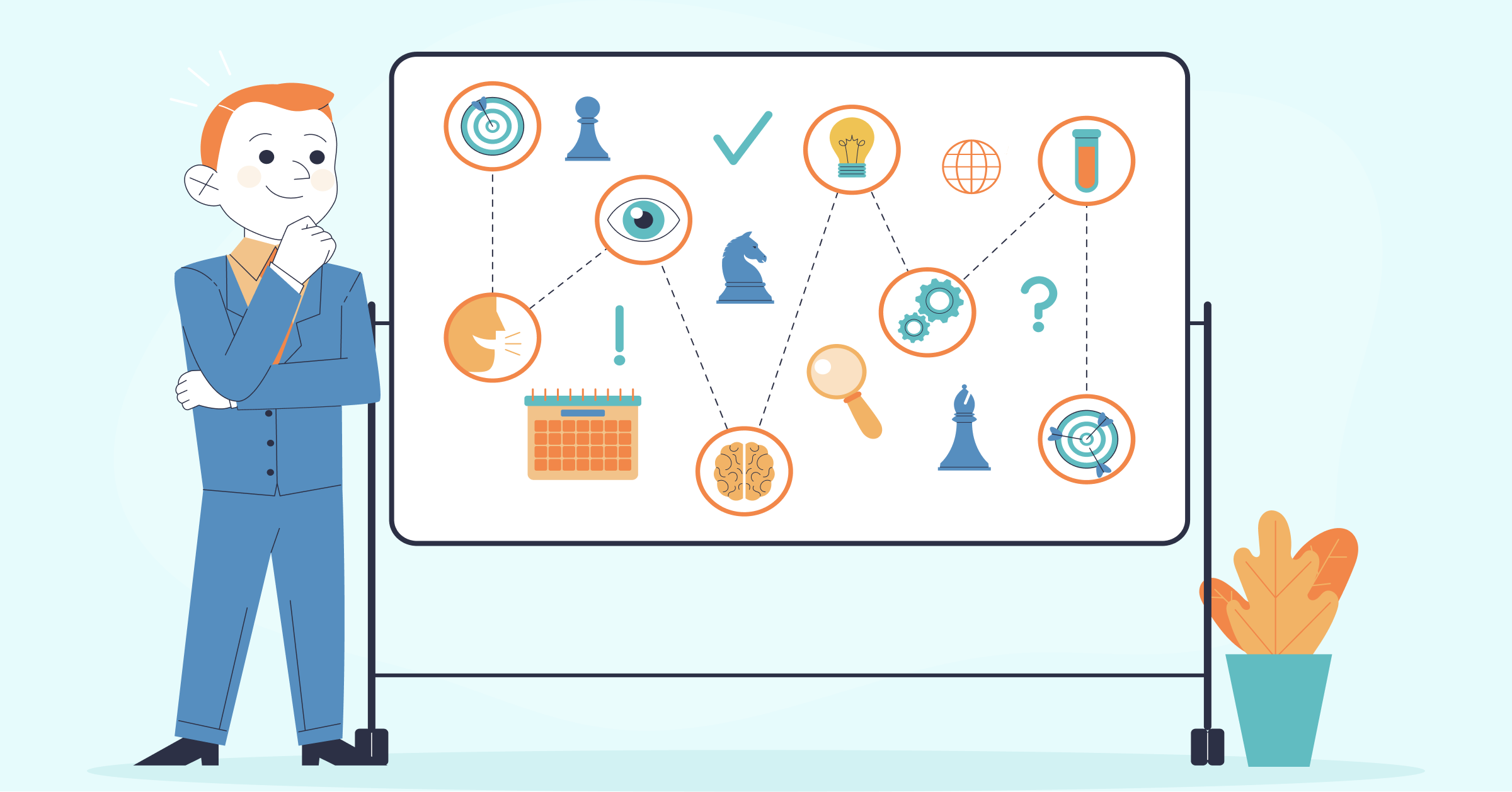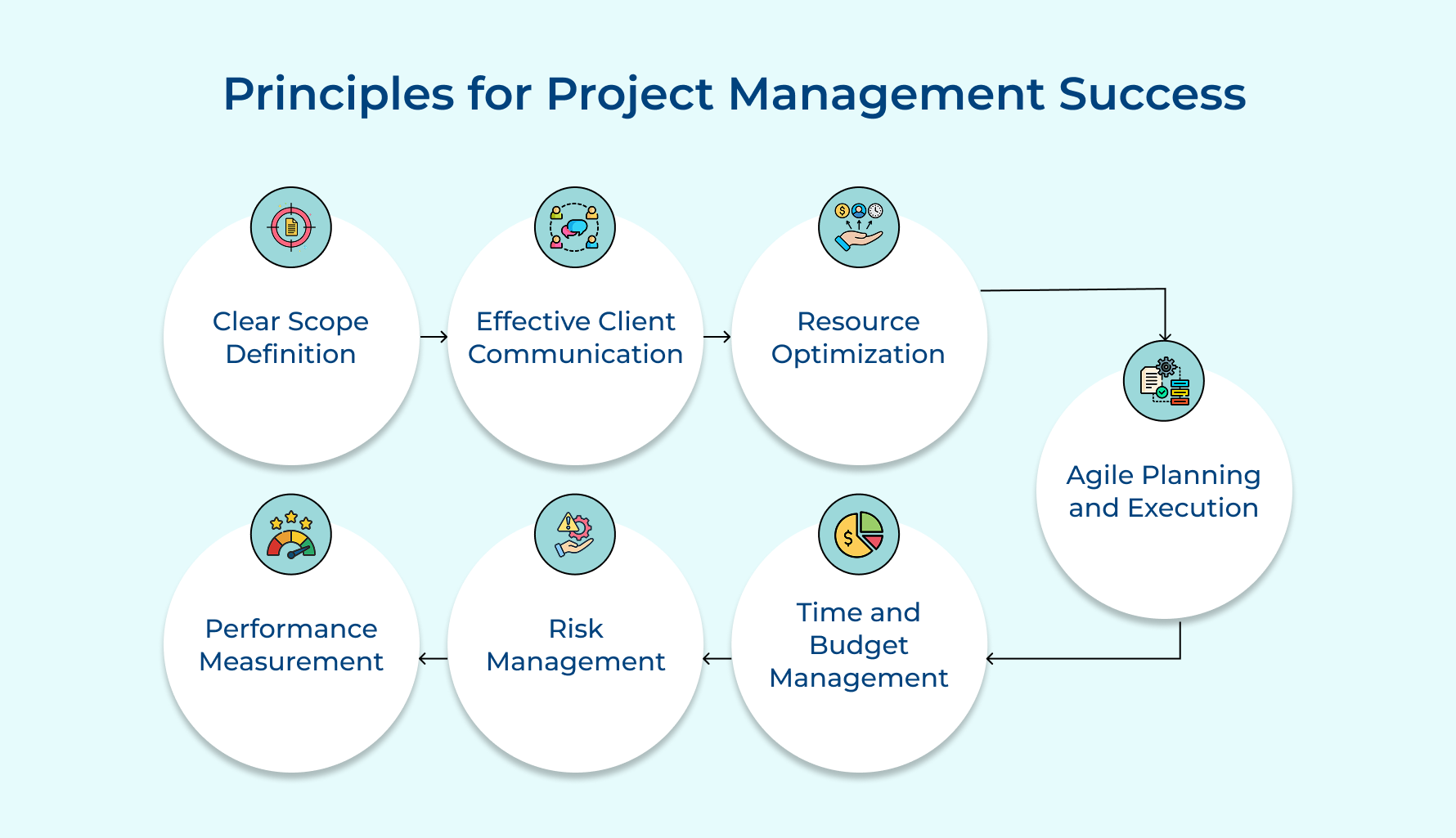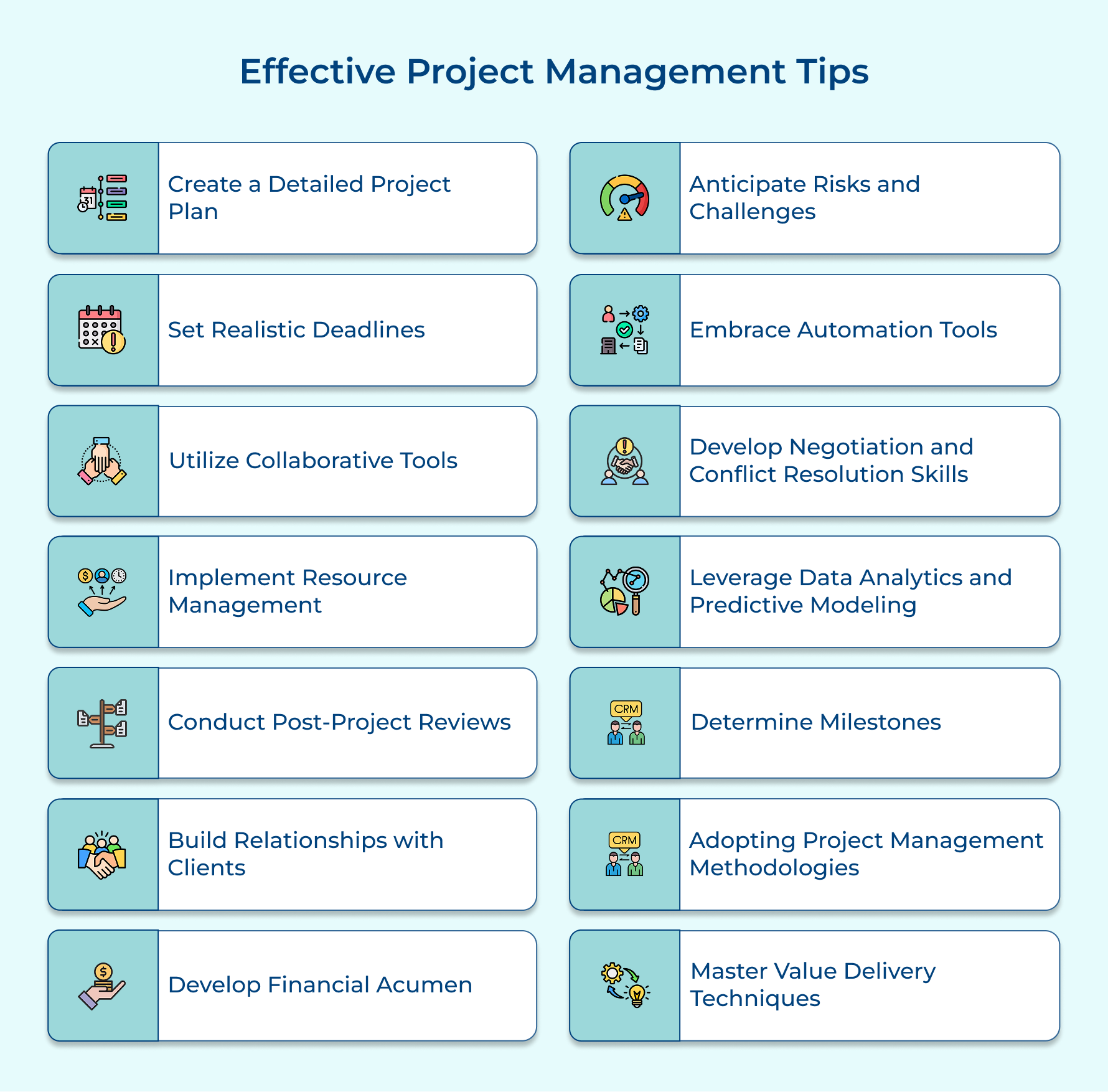14 Proven Project Management Tips for Professionals

Key Highlights
Project managers in professional services and consulting often face difficulties in delivering projects on time as well as within budget, leading to stress as well as client dissatisfaction.
Though 43% of the companies report that they deliver projects within budget most of the time, 91% of professionals working in project management state that their firms face challenges related to project management.
Now, these aspects do hinder your client relationships, adding to the already strained overall growth of the agency.
Then, what could be the best ways to improve your productivity?
Let’s explore essential project management tips designed to enhance efficiency and improve outcomes. Implementing these strategies will not only streamline processes but also strengthen client connections, ensuring long-term success in your projects.
Key Principles for Project Management Success
Understanding fundamental principles is crucial for successful project management. These principles guide decision-making and enhance project outcomes. Here are the essential concepts to consider.
Clear Scope Definition
Every agency as well as professional services firm wants one thing while starting on any project – start on the same page and stay there! But, how do you ensure things run smoothly?
A well-thought-out scope lays out exactly what’s getting delivered, when it’s due, and what the client should expect, so there are no surprises along the way. It is the only way you can avoid misunderstandings and reduce any scope creep.
Effective Client Communication
When the work scope is meticulously defined, and updated to the client (at regular intervals) to gather their opinion, it defines what a transparent communication should be. Though making this a habit takes time, it improves collaborations and builds trust – which means happier clients and smoother project journeys all around.
Agile Planning and Execution
Going agile in project planning and execution means embracing a responsive way of working. Rather than rigid, step-by-step planning, agile keeps things dynamic with ongoing check-ins, regular reassessments, and quick changes whenever circumstances shift or client needs change. It’s about adapting on the go, responding fast to any roadblocks, and integrating feedback in real time.
Resource Optimization
Let’s understand the basics of resource optimization first. When you know the strengths of each team member and their skillset, wouldn’t it become easier for you to allocate the right person to the right project?
Similarly, utilizing the right tools and technologies will make sure that the workload is balanced between the team members. The whole point of optimizing your resources is to make sure there’s high productivity and high-quality standards while managing the budget. Being confident of your resources maximizes good client relationships and overall outreach.
Time and Budget Management
One, or rather two crucial aspects that agencies easily miss out on is time and budget! Managing these two well is the secret to keeping projects profitable as well as clients happy. Set realistic timelines, clear milestones, and keep an eagle eye on expenses to stay financially sound with every project you take.
Risk Management
Smart risk management is when you spot, assess, and tackle potential threats that could become huge when neglected. Usually, you need contingency plans, regularly review risks, and come up with preventive measures. It ensures reduced disruptions, protects project objectives, and shows clients how professional your services are.
Performance Measurement
What is going well and what could be going well is the basis of measuring the performance. There should be a clear establishment of these metrics along with regular reviews. Ideally, the key measures include client feedback, considering team retrospectives, and analyzing project outcomes to refine the process for future projects.
14 Proven Project Management Tips for Professionals
Navigating project management in agencies requires specialized skills. This guide provides 15 practical tips to elevate your project management game. Here are the strategies you need.
Effective Project Management Tips for Professionals
Success in project management hinges on effective techniques. These five tips are essential for professionals looking to optimize their projects. Here are the key insights.
1. Create a Detailed Project Plan
A detailed project plan serves as a roadmap for the entire project lifecycle. There’s clarity on objectives, timelines, and resource allocation, helping to align all stakeholders as well as team members.
Create a WBS
Use the project plan as a living document throughout the project. Refer to it for task assignments, progress tracking, and deadline management. Update it regularly to reflect changes and use it as a communication tool with clients as well as team members to ensure everyone is on the same page.
For example, say you’re working on a multi-channel campaign. Break down the campaign into smaller, actionable parts: design, content, outreach, and reporting. Assign specific team members to each area with clear deadlines and responsibilities. This way, you can track progress, reassign tasks as needed, and manage deadlines all in one place.
2. Set Realistic Deadlines
Want to keep your team’s morale high while not compromising on quality deliverables? It might sound like a big deal, but with proper deadlines in place, managing the project becomes easy!
A realistic deadline helps balance the workload for your team. It should help you allocate resources efficiently, prioritize tasks, and guide client communications with ease. A regular update on project progress as well as delivery expectations reduces burnout, and errors in rushed work while contributing to more accurate productivity.
Best practices:
- Involve team members in the deadline-setting process, leveraging their expertise to estimate task durations more accurately.
- Build in buffer time for unexpected issues or client feedback rounds, typically adding 15-20% to your initial time estimates.
3. Utilize Collaborative Project Management Tools
Collaborative tools enhance team communication, streamline workflows, and increase productivity. They provide real-time project visibility, facilitate remote work, and help in tracking progress.
Implement these tools for task assignment, progress tracking, file sharing, and team communication. Use them to create dashboards for project overviews, generate reports for clients, and maintain a centralized repository of project-related information.
Enhancement tips:
- Choose a tool that integrates well with your existing systems and provides features tailored to agency needs, such as time tracking as well as client access portals.
- Provide thorough training to your team on using the chosen tool effectively, and establish clear guidelines for its usage across projects.
4. Implement Robust Resource Management
Imagine you’re juggling multiple campaigns with overlapping deadlines. By updating a resource allocation chart regularly, you can see at a glance who’s available, who’s stretched thin, and where support is needed.
Use resource management to balance work across your team, identify skill gaps, and make informed decisions about hiring or training needs. It helps in project planning, and timeline creation, as well as informs your agency’s growth strategy.
For instance, using a skills matrix can make it easy to match the right person to the right task. Say you’ve got a new client requiring SEO expertise—your skills matrix quickly shows who’s best suited or where a training opportunity might help. This insight not only improves your current project planning and timelines but also supports hiring or training decisions, contributing to your agency’s growth.
5. Conduct Thorough Post-Project Reviews
After you’ve completed your project, it is vital that you refer back to the journey. It gives a better picture of what worked well, what didn’t, and why! These aspects help in refining the process, and improving client satisfaction while also enhancing team performance.
Another great aspect of conducting post-project reviews is that you get insightful data for pitching to similar clients in the future. So, ensure to schedule a meeting right after the project completion as everyone has a fresh memory and can give better descriptions. Do not forget to build a template that covers every aspect of a project like goals, challenges, feedback, lessons, etc.
Practical Tips for Project Managers to Consider
Aspiring project managers benefit from practical advice to enhance their skills. These five tips provide a strong foundation for success. Here are the recommendations to follow.
6. Build Strong Relationships with Clients
Having a successful client relationship is beneficial to the agency’s growth. Isn’t that the only way you get more business? A good relationship translates to improved trust and communication.
Leverage strong client relationships to anticipate and address potential issues proactively, ensuring smoother project progression as well as higher client satisfaction in management consulting engagements.
How does it help project managers?
They get to navigate through challenges, manage expectations, and create value beyond project deliverables.
Here’s what you can do to improve your client relationship:
- Schedule regular check-ins with clients beyond formal project meetings to discuss their broader business challenges and goals.
- Develop a system to track and remember key client information, including personal notes, to personalize interactions as well as demonstrate genuine interest in their success.
7. Develop Financial Acumen
Remember we discussed a bit about finance in budget management in the above section? While setting realistic expectations is a given thought, financial acumen helps managers make informed decisions. Better decision-making trickles down to improved resource allocation.
Apply financial knowledge to create accurate project estimates, manage budgets effectively, and identify opportunities for cost optimization. The metrics help demonstrate project value to clients and internal stakeholders, supporting decision-making processes in management consulting engagements.
Do not forget to build a collaborative environment with your finance team to develop custom financial models tailored to your agency’s unique project types and cost structures.
8. Embrace Automation Tools
Automation such as AI-powered tools has revolutionized every industry all around the world! It can streamline repetitive tasks, improve data analysis, and free up time for strategic thinking along with maintaining client relationship management.
However, embracing the new changes can be a bit of a challenge. Here are a few things you can do to improve,
- Recognize the aspects that can be automated like task management, allocation, reporting, etc.
- Research the AI tools that could automate these procedures.
- Implement a pilot program for a new tool on a small project, gathering feedback and measuring impact before rolling it out agency-wide.
9. Anticipate Risks and Challenges
No agency owner says that their project is a walk in the park! Each project is complex and more often than not, unpredictable with last-minute changes.
Proactive risk management is the only factor that keeps your agency afloat as it keeps project momentum, protects client relationships, and ensures the delivery of high-quality solutions.
A robust risk assessment methodology in your project planning phase helps update risk profiles throughout the lifecycle. So, create a standard template tailored to your agency’s typical projects and update it regularly. Establish a “risk reserve” in your project plans, allocating additional time and budget to address unforeseen challenges without derailing the entire project.
10. Develop Strong Negotiation and Conflict Resolution Skills
In professional services, negotiation as well as conflict resolution skills are crucial for managing client expectations, and resolving disputes, all while navigating complex stakeholder relationships. These skills help maintain project momentum and preserve long-term client relationships amid challenges.
Negotiations are important skills during scope discussions, change requests, and resource allocation decisions. Meanwhile, conflict resolution techniques help address disagreements within the team or with clients, turning conflicts into opportunities for improved project outcomes.
Action tips for improving these skills are:
- Practice active listening techniques in all interactions, seeking to understand underlying needs and motivations in negotiations or conflicts.
- Develop a personal toolkit of conflict resolution strategies, and regularly reflect on which approaches work best in different situations you encounter.
Project Management Advanced Techniques for Achieving Expertise
Achieving expertise in project management requires advanced techniques and strategies. Let’s explore innovative methods to refine your approach.
11. Leverage Advanced Data Analytics and Predictive Modeling
A project manager would like to analyze more into project performance that will eventually help him improve outcomes as well as project success rates. Advanced data analytics and predictive modeling techniques are the right options to make data-driven decisions.
A data analytics tool analyzes the historical project data to identify patterns and predict outcomes, while predictive modeling helps forecast timelines, costs as well as risks. You can leverage these insights to refine plans and smoother running of the projects.
What else can you do to improve the process?
The first step should be to integrate data from various project management tools into a centralized data warehouse for comprehensive analysis. Then, develop custom predictive models tailored to your agency’s specific project types and key performance indicators.
12. Determine Milestones with Stakeholders
In a project’s lifetime, there is always a discrepancy between the project goals and what the stakeholders expect. A collaborative environment bridges this gap as it encourages buy-in, improves communication, and creates a shared vision of project success.
What you can do to enhance the bridge is to organize workshops with key stakeholders to jointly define project milestones. Involve stakeholders in building a realistic project plan with balanced objectives, constraints, and success criteria. Use visual tools like roadmaps or timeline software during milestone-setting sessions to facilitate clear communication and consensus-building.
13. Adopting Right Project Management Methodologies
Different methodologies suit different types of projects and organizational cultures. The right methodology enhances efficiency, improves team collaboration, and increases the likelihood of meeting project objectives.
There are three aspects to consider before selecting the most suitable methodology,
- Project requirements
- Team capabilities
- Organizational culture
These factors help you understand project types, team skills, and client preferences for selecting a methodology. A comprehensive training to your team on the chosen methodology. Regularly assess its effectiveness and be prepared to adapt or combine methodologies as needed for optimal results.
14. Master Value Delivery Techniques
When the agency focuses on delivering value, it ensures that it doesn’t just meet technical requirements but also provides tangible benefits to all stakeholders. It adds to stakeholder satisfaction, improves project outcomes, and contributes to long-term success.
Implement value-based decision-making processes throughout the project lifecycle. Regularly assess and communicate the value delivered to stakeholders. Use value delivery metrics to guide project prioritization, resource allocation, and change management processes.
Here are some actionable tips to consider,
- Develop a comprehensive stakeholder value map at the project outset, clearly linking project deliverables to specific stakeholder benefits.
- Implement regular “value check-ins” with key stakeholders to assess their perception of value delivery and adjust project direction if necessary.
The Impact of Strong Project Management Tips on Profitability
Effective project management is essential for achieving successful outcomes. Creating detailed project plans, setting realistic deadlines, using advanced analytics, and harnessing AI can greatly improve a project manager’s success in delivering positive results.
The key to excellence lies in continuous learning, adapting to new technologies, and maintaining strong stakeholder relationships. Embracing these techniques, staying flexible, and consistently pushing the boundaries of expertise will elevate your project management skills. Remember, each project is an opportunity to refine your approach and achieve greater success.
Limit time — not creativity
Everything you need for customer support, marketing & sales.
Neeti Singh is a passionate content writer at Kooper, where he transforms complex concepts into clear, engaging and actionable content. With a keen eye for detail and a love for technology, Tushar Joshi crafts blog posts, guides and articles that help readers navigate the fast-evolving world of software solutions.

